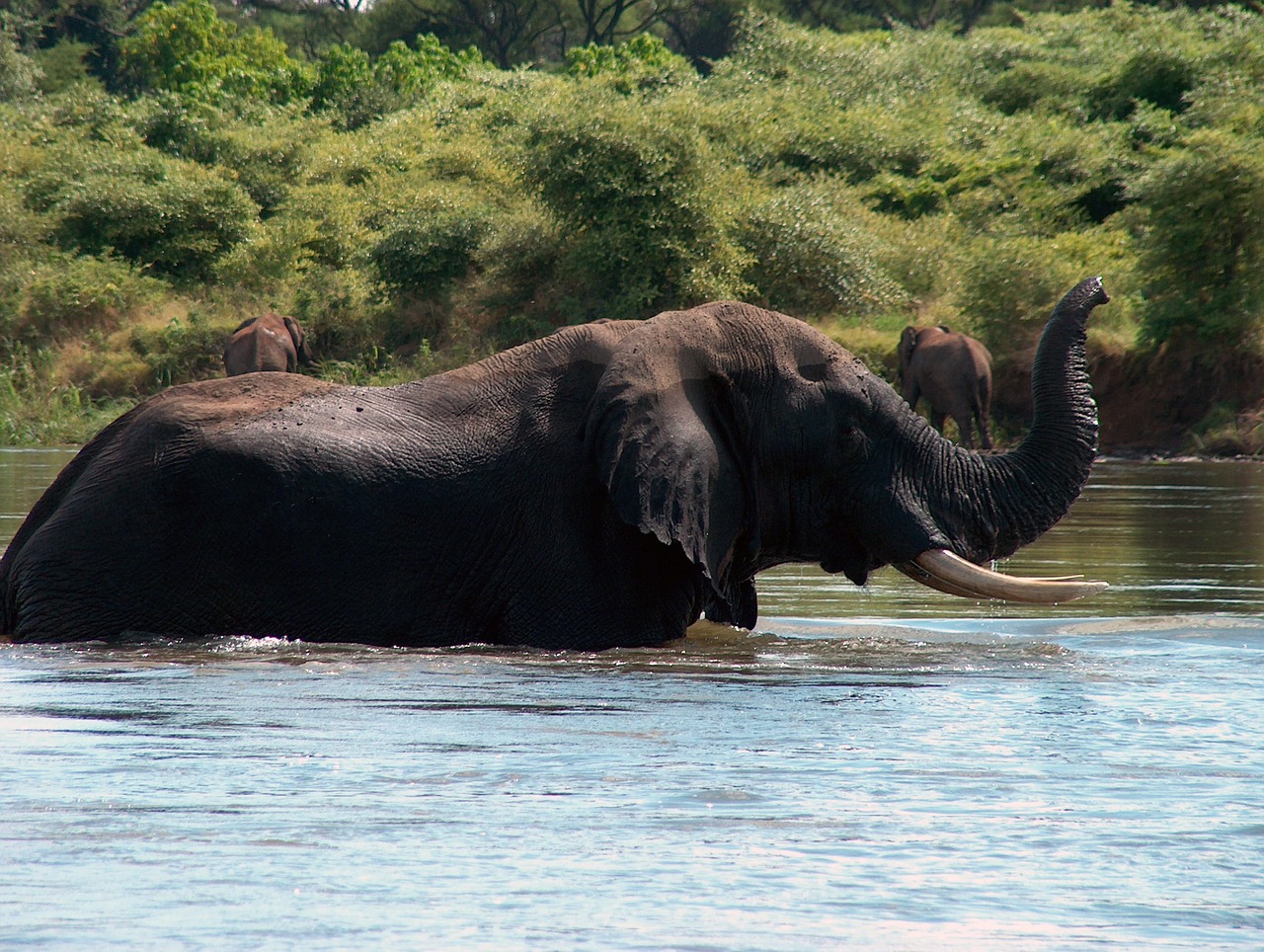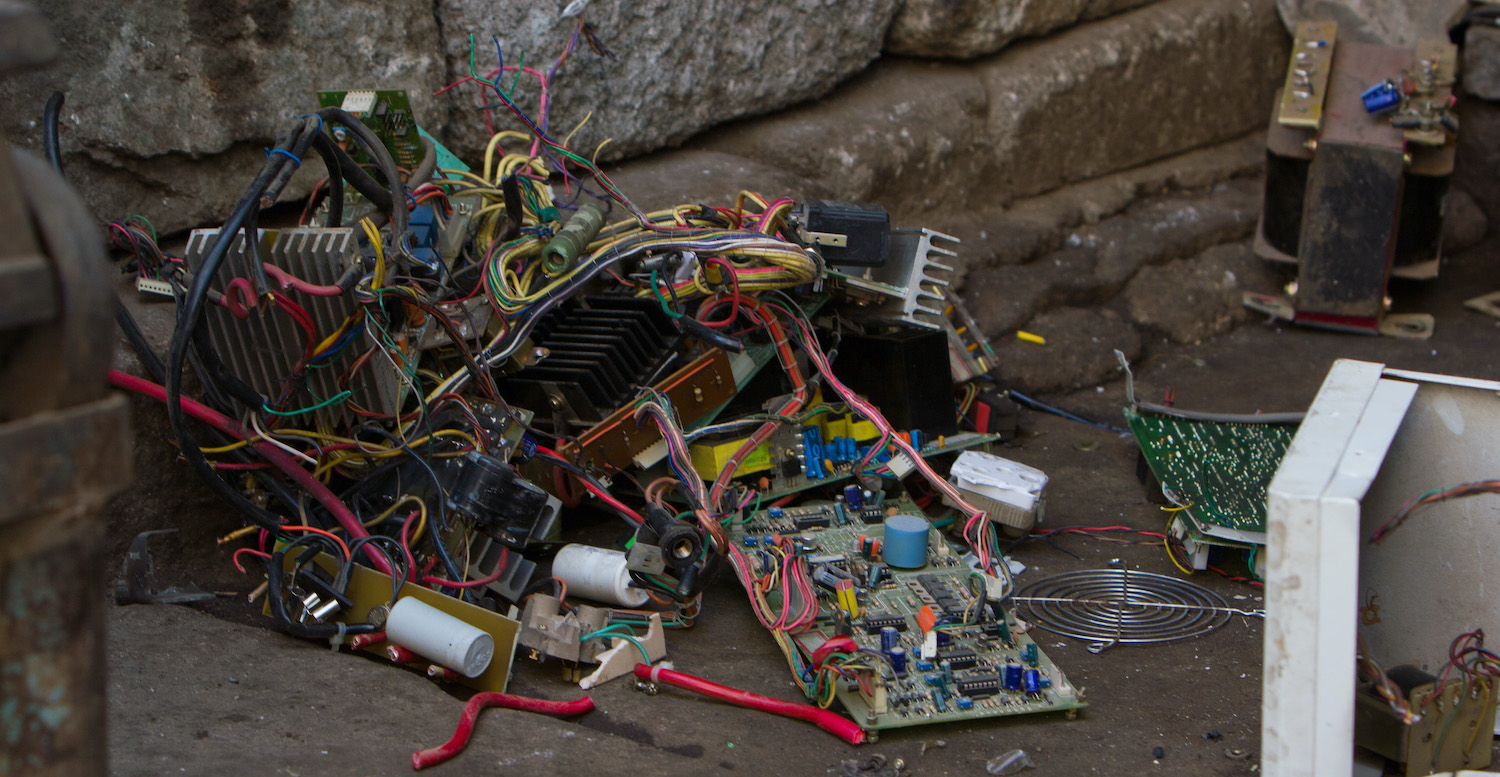
by DGR News Service | Sep 15, 2020 | Climate Change, Mining & Drilling, The Problem: Civilization
This is the fourth part in the series. In the previous essays, we have explored the need for a collapse, the relationship between a Dyson sphere and overcomsumption, and our blind pursuit for ‘progress.’ In this piece, Elisabeth describes how the Dyson sphere is an extension of the drive for so-called “green energy.”
By Elisabeth Robson
Techno-utopians imagine the human population on Earth can be saved from collapse using energy collected with a Dyson Sphere–a vast solar array surrounding the sun and funneling energy back to Earth–to build and power space ships. In these ships, we’ll leave the polluted and devastated Earth behind to venture into space and populate the solar system. Such a fantasy is outlined in “Deforestation and world population sustainability: a quantitative analysis” and is a story worthy of Elon Musk and Jeff Bezos. It says, in so many words: we’ve trashed this planet, so let’s go find another one.
In their report, Mauro Bologna and Gerardo Aquino present a model that shows, with continued population growth and deforestation at current rates, we have a less than 10% chance of avoiding catastrophic collapse of civilization within the next few decades. Some argue that a deliberate and well-managed collapse would be better than the alternatives. Bologna and Aquino present two potential solutions to this situation. One is to develop the Dyson Sphere technology we can use to escape the bonds of our home planet and populate the solar system. The other is to change the way we (that is, those of us living in industrial and consumer society) live on this planet into a ‘cultural society’, one not driven primarily by economy and consumption, in order to sustain the population here on Earth.
The authors acknowledge that the idea of using a Dyson Sphere to provide all the energy we need to populate the solar system is unrealistic, especially in the timeframe to avoid collapse that’s demonstrated by their own work. They suggest that any attempt to develop such technology, whether to “live in extraterrestrial space or develop any other way to sustain population of the planet” will take too long given current rates of deforestation. As Salonika describes in an earlier article in this series, “A Dyson Sphere will not stop collapse“, any attempt to create such a fantastical technology would only increase the exploitation of the environment.
Technology makes things worse
The authors rightly acknowledge this point, noting that “higher technological level leads to growing population and higher forest consumption.” Attempts to develop the more advanced technology humanity believes is required to prevent collapse will simply speed up the timeframe to collapse. However, the authors then contradict themselves and veer back into fantasy land when they suggest that higher technological levels can enable “more effective use of resources” and can therefore lead, in principle, to “technological solutions to prevent the ecological collapse of the planet.”
Techno-utopians often fail to notice that we have the population we do on Earth precisely because we have used technology to increase the effectiveness (and efficiency) of fossil fuels and other resources* (forests, metals, minerals, water, land, fish, etc.). Each time we increase ‘effective use’ of these resources by developing new technology, the result is an increase in resource use that drives an increase in population and development, along with the pollution and ecocide that accompanies that development. The agricultural ‘green revolution’ is a perfect example of this: advances in technology enabled new high-yield cereals as well as new fertilizers, pesticides, herbicides, irrigation, and mechanization, all of which prevented widespread famine, but also contributed to an ongoing explosion in population, development, chemical use, deforestation, land degradation and salinization, water pollution, top soil loss, and biodiversity loss around the world.
As economist William Stanley Jevons predicted in 1865, increasing energy efficiency with advances in technology leads to more energy use. Extrapolating from his well-proved prediction, it should be obvious that new technology will not prevent ecological collapse; in fact, such technology is much more likely to exacerbate it.
This mistaken belief that new technology can save us from collapse pervades the policies and projects of governments around the world.
Projects like the Green New Deal, the Democrat Party’s recently published climate plan, and the UN’s sustainable development goals and IPCC recommendations. All these projects advocate for global development and adoption of ‘clean technology’ and ‘clean industry’ (I’m not sure what those terms mean, myself); ’emissions-free’ energy technologies like solar, wind, nuclear and hydropower; and climate change mitigation technologies like carbon capture and storage, smart grids, artificial intelligence, and geo-engineering. They tout massive growth in renewable energy production from wind and solar, and boast about how efficient and inexpensive these technologies have become, implying that all will be well if we just keep innovating new technologies on our well worn path of progress.
Miles and miles of solar panels, twinkling like artificial lakes in the middle of deserts and fields; row upon row of wind turbines, huge white metal beasts turning wind into electricity, and mountain tops and prairies into wasteland; massive concrete dams choking rivers to death to store what we used to call water, now mere embodied energy stored to create electrons when we need them–the techno-utopians claim these so-called clean’ technologies can replace the black gold of our present fantasies–fossil fuels–and save us from ourselves with futuristic electric fantasies instead.
All these visions are equally implausible in their capacity to save us from collapse.
And while solar panels, wind turbines, and dams are real, in the sense that they exist–unlike the Dyson Sphere–all equally embody the utter failure of imagination we humans seem unable to transcend. Some will scoff at my dismissal of these electric visions, and say that imagining and inventing new technologies is the pinnacle of human achievement. With such framing, the techno-utopians have convinced themselves that creating new technologies to solve the problems of old technologies is progress. This time it will be different, they promise.
And yet if you look at the graph of global primary energy consumption:

it should be obvious to any sensible person that new, so-called ‘clean’ energy-producing technologies are only adding to that upward curve of the graph, and are not replacing fossil fuels in any meaningful way. Previous research has shown that “total national [US] energy use from non-fossil-fuel sources displaced less than one-quarter of a unit of fossil-fuel energy use and, focussing specifically on electricity, each unit of electricity generated by non-fossil-fuel sources displaced less than one-tenth of a unit of fossil-fuel-generated electricity.”
In part, this is due to the fossil fuel energy required to mine, refine, manufacture, install, maintain, and properly dispose of materials used to make renewable and climate mitigation technologies. Mining is the most destructive human activity on the planet, and a recent University of Queensland study found that mining the minerals and metals required for renewable energy technology could threaten biodiversity more than climate change. However, those who use the word “clean” to describe these technologies conveniently forget to mention these problems.
Wind turbines and solar arrays are getting so cheap; they are being built to reduce the cost of the energy required to frack gas: thus, the black snake eats its own tail. “Solar panels are starting to die, leaving behind toxic trash”, a recent headline blares, above an article that makes no suggestion that perhaps it’s time to cut back a little on energy use. Because they cannot be recycled, most wind turbine blades end up in landfill, where they will contaminate the soil and ground water long after humanity is a distant memory. Forests in the southeast and northwest of the United States are being decimated for high-tech biomass production because of a loophole in EU carbon budget policy that counts biomass as renewable and emissions free. Dams have killed the rivers in the US Pacific Northwest, and salmon populations are collapsing as a result. I could go on.
The lies we tell ourselves
Just like the Dyson Sphere, these and other technologies we fantasize will save our way of life from collapse are delusions on a grand scale. The governor of my own US state of Washington boasts about how this state’s abundant “clean” hydropower energy will help us create a “clean” economy, while at the same time he fusses about the imminent extinction of the salmon-dependent Southern Resident Orca whales. I wonder: does he not see the contradiction, or is he willfully blind to his own hypocrisy?
The face of the Earth is a record of human sins (1), a ledger written in concrete and steel; the Earth twisted into skyscrapers and bridges, plows and combines, solar panels and wind turbines, mines and missing mountains; with ink made from chemical waste and nuclear contamination, plastic and the dead bodies of trees. The skies, too, tell our most recent story. Once source of inspiration and mythic tales, in the skies we now see airplanes and contrails, space junk and satellites we might once have mistaken for shooting stars, but can no longer because there are so many; with vision obscured by layers of too much PM2.5 and CO2 and NOx and SO2 and ozone and benzene. In the dreams of techno-utopians, we see space ships leaving a rotting, smoking Earth behind.
One of many tales of our Earthly sins is deforestation.
As the saying goes, forests precede us, and deserts follow; Mauro Bologna and Gerardo Aquino chose a good metric for understanding and measuring our time left on Earth. Without forests, there is no rain and the middles of continents become deserts. It is said the Middle East, a vast area we now think of as primarily desert, used to be covered in forests so thick and vast the sunlight never touched the ground (2). Without forests, there is no home for species we’ve long since forgotten we are connected to in that web of life we imagine ourselves separate from, looking down from above as techno-gods on that dirty, inconvenient thing we call nature, protected by our bubble of plastic and steel. Without forests, there is no life.
One part of one sentence in the middle of the report gives away man’s original sin: it is when the authors write, “our model does not specify the technological mechanism by which the successful trajectories are able to find an alternative to forests and avoid collapse“. Do they fail to understand that there is no alternative to forests? That no amount of technology, no matter how advanced–no Dyson Sphere; no deserts full of solar panels; no denuded mountain ridges lined with wind turbines; no dam, no matter how wide or high; no amount of chemicals injected into the atmosphere to reflect the sun–will ever serve as an “alternative to forests”? Or are they willfully blind to this fundamental fact of this once fecund and now dying planet that is our only home?
A different vision
I’d like to give the authors the benefit of the doubt, as they end their report with a tantalizing reference to another way of being for humans, when they write, “we suggest that only civilisations capable of a switch from an economical society to a sort of ‘cultural’ society in a timely manner, may survive.” They do not expand on this idea at all. As physicists, perhaps the authors didn’t feel like they had the freedom to do so in a prestigious journal like Nature, where, one presumes, scientists are expected to stay firmly in their own lanes.
Having clearly made their case that civilized humanity can expect a change of life circumstance fairly soon, perhaps they felt it best to leave to others the responsibility and imagination for this vision. Such a vision will require not just remembering who we are: bi-pedal apes utterly dependent on the natural world for our existence. It will require a deep listening to the forests, the rivers, the sky, the rain, the salmon, the frogs, the birds… in short, to all the pulsing, breathing, flowing, speaking communities we live among but ignore in our rush to cover the world with our innovations in new technology.
Paul Kingsnorth wrote: “Spiritual teachers throughout history have all taught that the divine is reached through simplicity, humility, and self-denial: through the negation of the ego and respect for life. To put it mildly, these are not qualities that our culture encourages. But that doesn’t mean they are antiquated; only that we have forgotten why they matter.”
New technologies, real or imagined, and the profits they bring is what our culture reveres.
Building dams, solar arrays, and wind turbines; experimenting with machines to capture CO2 from the air and inject SO2 into the troposphere to reflect the sun; imagining Dyson Spheres powering spaceships carrying humanity to new frontiers–these efforts are all exciting; they appeal to our sense of adventure, and align perfectly with a culture of progress that demands always more. But such pursuits destroy our souls along with the living Earth just a little bit more with each new technology we invent.
This constant push for progress through the development of new technologies and new ways of generating energy is the opposite of simplicity, humility, and self-denial. So, the question becomes: how can we remember the pleasures of a simple, humble, spare life? How can we rewrite our stories to create a cultural society based on those values instead? We have little time left to find an answer.
* I dislike the word resources to refer to the natural world; I’m using it here because it’s a handy word, and it’s how most techno-utopians refer to mountains, rivers, rocks, forests, and life in general.
(1) Susan Griffin, Woman and Nature
(2) Derrick Jensen, Deep Green Resistance
In the final part of this series, we will discuss what the cultural shift (as described by the authors) would look like.
Featured image: e-waste in Bangalore, India at a “recycling” facility. Photo by Victor Grigas, CC BY SA 3.0.
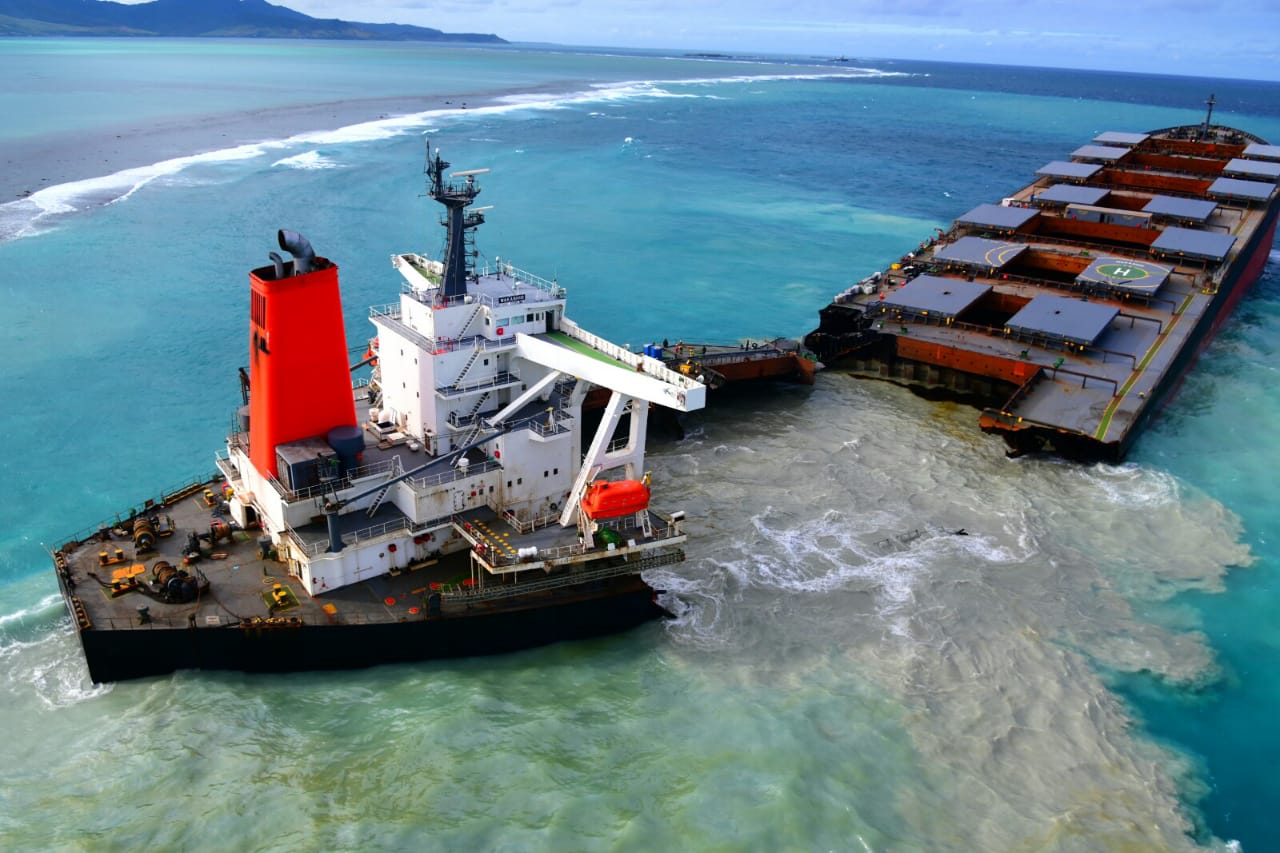
by DGR News Service | Sep 11, 2020 | Biodiversity & Habitat Destruction
This article was written by Malavika Vyawahare on 1 September 2020 and originally published on Mongabay.
- People gathered in the thousands in Mauritius’s capital, Port Louis, to protest the government’s response to a recent oil spill.
- The Japanese-owned freighter M.V. Wakashio crashed into the coral reef barrier off the island’s southeastern coast on July 25 and leaked about 1,000 tons of fuel oil into the sea near ecologically sensitive areas, before breaking in half a few weeks later.
- The stranding of at least 39 dolphins and whales near the site has sparked an outcry, though a link between the Wakashio shipwreck and the beachings has not yet been established.
- In a controversial move, the Mauritian government decided to sink the front half of the ship several kilometers away from the crash site in open waters, which some experts say could have impacted the dolphin and whale populations.
Thousands of people demonstrated in Mauritius on Aug. 29 over the government’s handling of a recent ship grounding that spilled 1,000 tons oil in the seas around the island nation. In what appears to be the latest toll in the incident, dolphins and whales have beached close to where the M.V. Wakashio freighter ran aground and broke up. Thirty-nine of the mammals have beached in the week to Aug. 28. Social media is awash with photos of the stranded animals, including mothers and calves.
At a press conference Sudheer Maudhoo, the Mauritian fisheries, marine resources and shipping minister, called the beachings a “sad coincidence.” Though a link between the deaths and oil contamination has yet to be established, disaffection has swelled in the aftermath of the spill, with protesters taking to the streets of the capital, Port Louis, and wielding an inflatable dolphin with “Inaction” written on it.
The Wakashio struck the coral reef barrier off the country’s southeastern coast on July 25; the damage to its fuel tankers led to a leak on Aug. 6. The fact that the ship lay lodged in the coral reef for more than 10 days before any decisive action by the government has become a sour point for Mauritians demanding answers from the authorities.
“The oil spill became like a culmination of growing frustration in the country. Since we have this new government, there were a series of issues and the Wakashio oil spill was the last straw,” said Mokshanand Sunil Dowarkasing, a former member of parliament who now works with Greenpeace in Mauritius. The vessel lay stranded in the vicinity of at least three sites of ecological significance: Blue Bay Marine Area; Pointe d’Esny, the largest remaining wetland in Mauritius; and the coral isle of Ile aux Aigrettes, which is a nature reserve. Facing mounting pressure from abroad and within the country, the government hastened efforts to pump out the oil that remained on board, even as a ship was at the brink of breaking apart. On Aug. 15, it broke into two, but by then most of the oil on board had been removed. The situation, however, has only grown murkier since.
This article was written by Malavika Vyawahare on 1 September 2020 and originally published on Mongabay. The original article can be accessed here:
https://news.mongabay.com/2020/09/mauritians-take-to-the-street-over-oil-spill-and-dolphin-and-whale-deaths/

by DGR News Service | Sep 4, 2020 | Biodiversity & Habitat Destruction
This piece was originally published in Earth Island Journal.
Zambia and Zimbabwe plan to move ahead with the $4 billion Batoka Gorge Dam that would displace villagers, wildlife, and a vibrant rafting industry along the Zambezi River.
by Rebecca Wilbear/Earth Island Journal
More than 50 men traverse the steep, rocky gorge. They balance as many as three kayaks on their back each, along with other equipment for rafting companies offering trips in the Batoka Gorge. Sweat glistens on their skin; they earn a dollar for each kayak. These porters come from the Indigenous Tokaleya villages situated along the edge of the gorge, on either side of the Zambia-Zimbabwe border. For the Tokaleya, the Zambezi River is an essential and sacred deity. It’s also a source of income. Tens of thousands of tourists raft the Zambezi’s rapids each year, drawn to the region’s rich ecosystem. Alongside the Tokeleya, birds, fish, and other wildlife make their home in the gorge.
Yet the section of the river that runs through Batoka Gorge is threatened. In June 2019, the General Electric Company of the United States and the Power Construction Corporation of China signed a deal with the Zambian and Zimbabwean governments to build and finance the Batoka Gorge Dam. The danger from a massive hydroelectric project, which was first proposed nearly 70 years ago, has become urgent.
Africa’s fourth largest river, the Zambezi flows through six countries. The Batoka Gorge section begins at the bottom of Victoria Falls, the largest waterfall in the world, also called Mosi-oa-Tunya, or “The Smoke That Thunders.” A few miles from Livingstone, Zambia, massive roaring waters spill from the sky and turn clear green as the river races through steep, dark canyon walls down the 50-mile gorge. The river then meanders for another 200 miles until it reaches Lake Kariba, the world’s largest reservoir by volume and an example of what Batoka Gorge could become.
I am a river guide, and in October 2019, I embarked on a four-day trip down Batoka Gorge as part of a two-week river guide training. Most of our guides, Melvin Ndelelwa, James Linyando, and Emmanuel Ngenda, were from the Tokaleya villages. Ndelelwa, who was a porter before becoming a river guide, pulled out a picture of a fish he caught at a hidden pool below the falls. It was almost as big as he is. His father was a porter his whole life. Becoming a raft guide in Zambia is hard work. The possibility of learning to guide energizes the porters.
Ndelelwa explains how his younger brother carves ebony root to make Nyami Nyami necklaces. The Nyami Nyami is a mythic river god, a serpent with the head of a fish. Legend has it, this god is angry that his sweetheart is trapped downstream behind the giant Kariba Dam. In 1956, a year into construction, the Nyami Nyami flooded the river, wreaking havoc on the construction site. The odds of another flood in 1957 were a thousand to one. Yet the river rose three meters higher than before, destroying the bridge, cofferdam, and parts of the main wall.
The guides told us that the Nyami Nyami would protect us when we wear the necklace that honors his sweetheart. On the river, I touched mine often, praying for safe passage. I am terrified of big water and scared of flipping. The Zambezi is a huge volume river with little exposed rock. It is extremely challenging, with long and powerful rapids, steep gradients, and big drops. Flipping is common. In high-pressure areas, you can’t even depend on your life jacket to keep your head above water.
On the river, I clung to the raft in awe and terror at the size of the waves. October is the dry season, when the water is low. In December, the rains raise the river and turn it muddy brown. Linyando navigated ahead in a safety kayak while Ngenda captained our raft. At one point between rapids, he pointed out the camouflaged crocodiles sun-bathing on rocks.
Halfway through the training, I was invited to guide the most challenging rapid, Gulliver’s Travels. I had already guided the rapid just prior called Devil’s Toilet Bowl twice, but my angle was off on this third attempt. The raft flipped backwards. I went deep underwater. It was dark and silent. A shaft of light appeared. Then more light. I surfaced. We turned the boat upright, but my confidence was shaken. I thought of backing out of Gulliver’s Travels, until the guides encouraged me. Back in the boat, I sent the raft through.
Throughout the trip, I felt that the guides protected me. Ndelelwa offered his sandal for the steep hike out after I lost my shoe. “This is my home,” he said. “It’s easy for me to walk barefoot.” Later, when I encountered a puff adder — a venomous snake with a bite that can be deadly — near my sleeping bag, Ngenda helped me move closer to the fire. “We sleep here,” he said. “The snakes don’t like fire.” It smolders all night smoking fish for breakfast, a staple food in villages along the gorge.
 IN 2015, THE WORLD BANK funded an Environmental and Social Impact Assessment (ESIA) that concluded that the dam is a “cheap” solution to the “electricity deficit” of Zambia and Zimbabwe. An airport and road have already been constructed. The reservoir of the 550-foot tall mega-dam will be 16 square miles and a half-mile from the put-in just below Victoria Falls, impacting a UNESCO World Heritage Site sacred to the Tokaleya peoples. The entire canyon will be drowned and destroyed.
IN 2015, THE WORLD BANK funded an Environmental and Social Impact Assessment (ESIA) that concluded that the dam is a “cheap” solution to the “electricity deficit” of Zambia and Zimbabwe. An airport and road have already been constructed. The reservoir of the 550-foot tall mega-dam will be 16 square miles and a half-mile from the put-in just below Victoria Falls, impacting a UNESCO World Heritage Site sacred to the Tokaleya peoples. The entire canyon will be drowned and destroyed.
If the dam build goes ahead, wildlife who live and breed in the gorge will be lost or displaced. The Cornish jack and bottlenose fish need fast-moving water to survive. The extremely rare Taita falcon is endemic to Batoka Gorge — it nests and breeds only here. The hooves of the small klipspringer antelope are designed to jump up and down the canyon. They will not be able to live on top. Leopards that live in the gorge will be forced to move to higher ground, becoming more vulnerable to hunting and poaching.
The ecological damage is layered with the human toll. Downstream from Batoka Gorge, the Kariba Dam, built in the late 1950s, displaced 57,000 Indigenous Gwembe Tonga and Kore Kore peoples, while stranding thousands of animals on islands. Kariba Dam has also demonstrated that imprisoning a river damages water quality, reduces the amount of water available for people and wildlife downstream, and harms the fertility of the land. Dams can also spread waterborne diseases such as malaria and schistosomiasis, while mega-dams may cause earthquakes and destructive floods.
Plus, the lifespan of a dam is 50 years. Less than 30 years after construction, Kariba Dam began falling apart, causing earthquakes and operating at less than 30 percent its proposed capacity. Falling water levels have made it increasingly less productive. The Chinese construction company regularly pours concrete into the wall to keep it from buckling. If it broke, it could cause a tsunami that would impact much of Mozambique and even Madagascar, potentially killing millions.
The Batoka Gorge project will cost around four billion dollars. It is supposed to take 10 to 13 years to complete, but some locals have noticed that high cost infrastructure projects often do not reach completion in Zambia. Increasing droughts due to climate change raise the question whether there will be enough water to operate a dam. Electricity generated is likely to be sold to foreign countries for income, while local people become poorer.
The dam will also displace river guides and most likely the villages along the gorge. Tourism is the third largest industry in Zambia. The governments say the dam’s construction will create jobs, but many of these jobs go to Chinese nationals hired by Chinese companies, and after construction ends, few will be needed to operate the dam. Some say the dam will create new tourism opportunities, like parasailing and wakeboarding, but crocodiles and hippos proliferate in flat water, making these activities risky.
China is rapidly expanding its global reach, including in Africa, through its Belt and Road Initiative, an ambitious infrastructure project extending to 60 countries and counting. The country has already financed two Zambian airports and the Itezhi Tezhi Dam, and owns a 60 percent share of Zambia national broadcasting service. As many less developed countries borrow big money from China for big infrastructure projects, they are incurring large debts. The debt incurred can be crushing to the food supplies, health services, and education of local people. As Daimone Siulapwa writes in the Zambian Observer, huge kickbacks are the root of the problem. They motivate Zambian leaders to negotiate deals with China. Millions of dollars go missing. Projects are not finished. The natural world and local people suffer.
Most river guides hope the dam never happens, but local rafting companies are afraid to speak out against it. They fear repercussions — from being shot to having their passport or business license revoked. International support is imperative if we want to see this river protected.
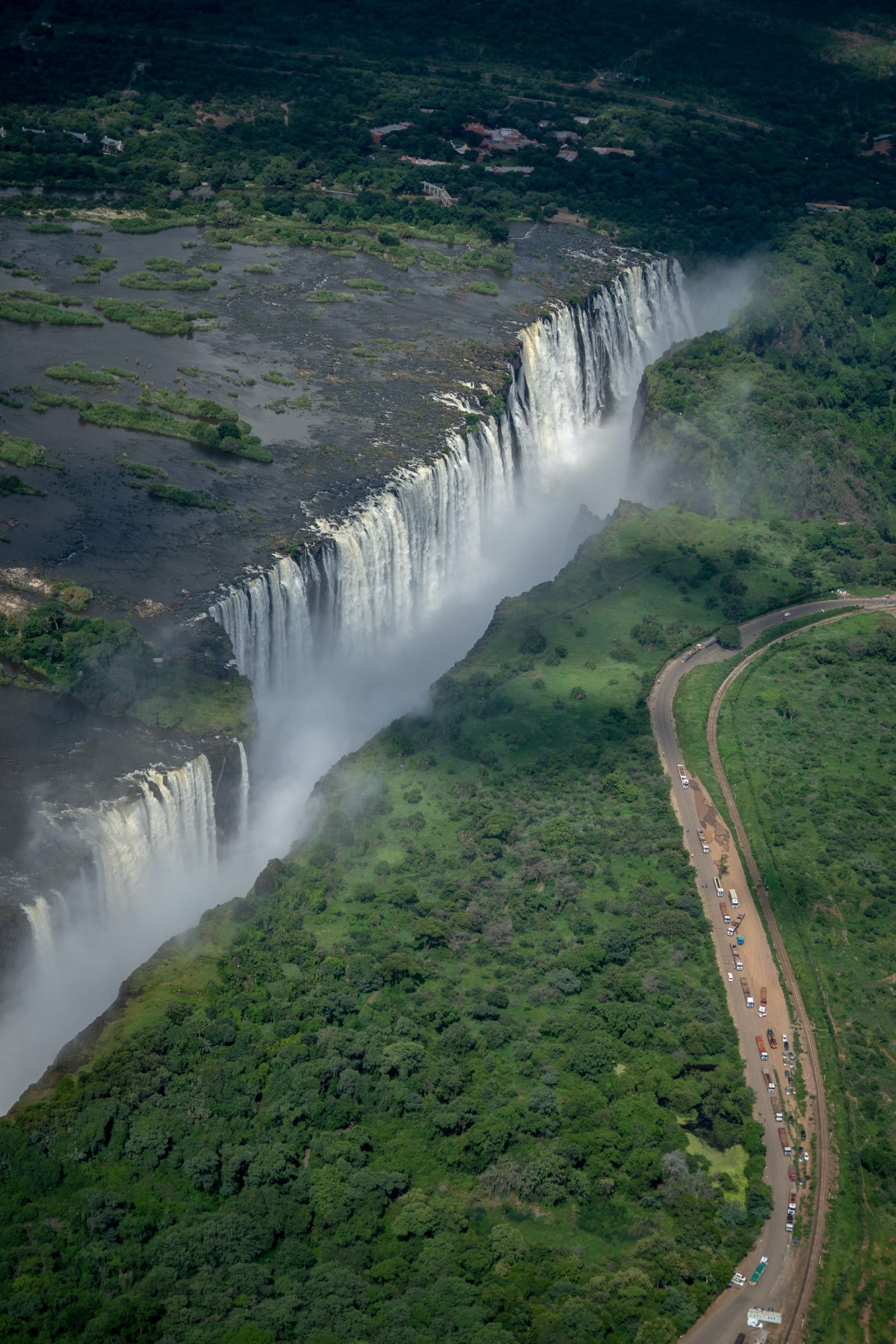
ALONG THE RIVER, villagers carve and sell wooden figurines: elephants, rhinos, lions, water buffalo. Ndelelwa always buys some, though he does not need them. I bought carvings too, and the vendor insisted on giving me a few extra.
Then Ndelelwa invited me to his village to eat nshima, a traditional thick maize porridge. We sat outside the round mud huts with grass roofs. Five children ran over to look at me with toothy smiles and a wide-eyed curiosity. As we ate from one bowl, I thanked them in their dialect, “Ndalumba.”
If the river is dammed, I wonder, what will happen to these people? How will they survive?
The last time I flipped the raft on the Zambezi, the waves were gentle. We held the perimeter rope of the capsized boat as we floated through a narrow section of canyon. Ngenda smiled as he turned the boat upright.
Dam projects are rarely stopped in industrial civilization. Save the Zambezi formed to oppose the construction of this dam. They seek help in challenging the ESIA. This dam will likely go ahead unless there is an unprecedented outcry of resistance. The Nyami Nyami protected us on the river. Perhaps his rage may once again knock down any walls placed in his path. I touch my necklace and pray for the river.
Help stop the Batoka Gorge Dam:
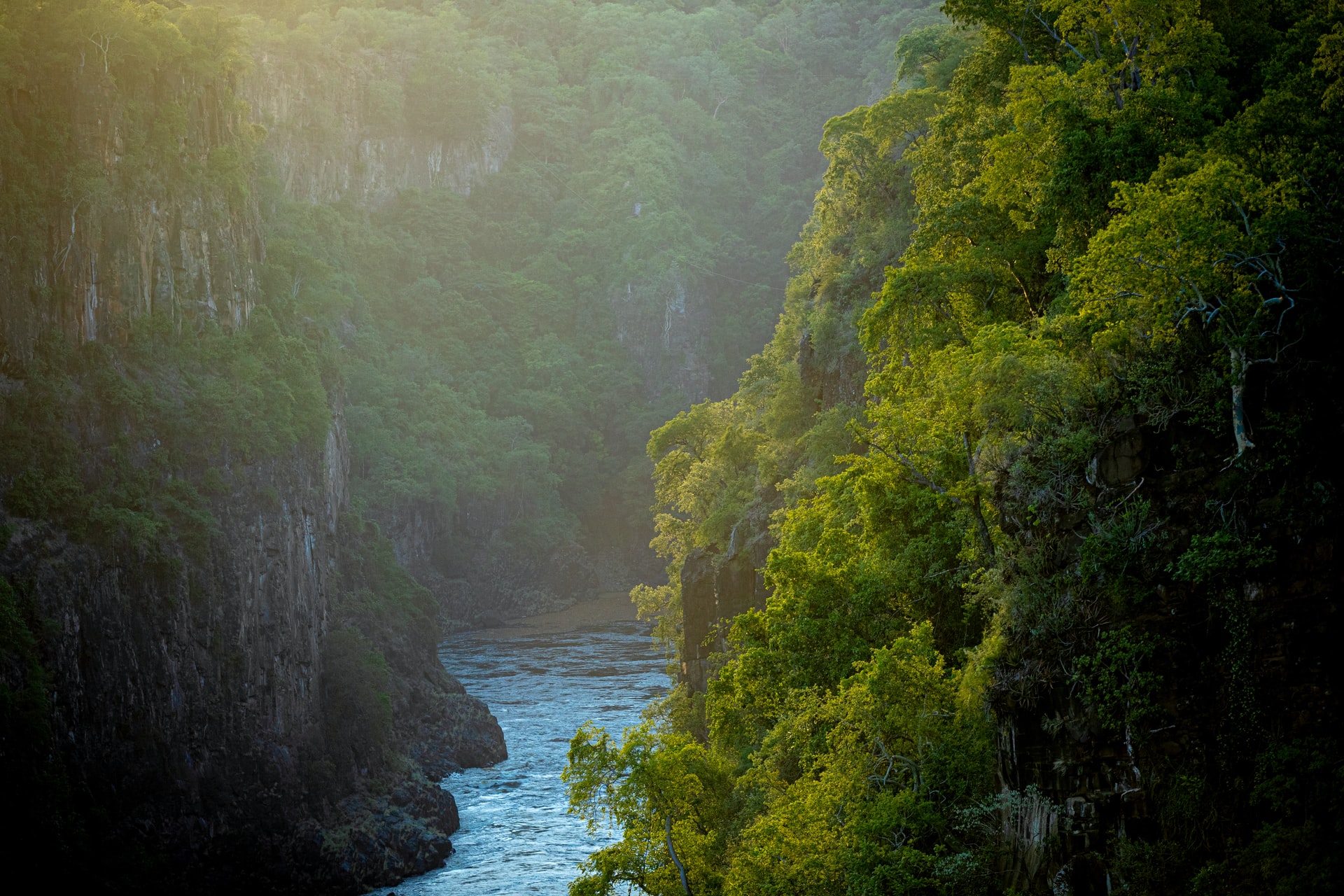 Rebecca Wildbear is a river and soul guide who helps people tune in to the mysteries that live within the Earth community, dreams, and their own wild Nature, so they may live a life of creative service. She has been a guide with Animas Valley Institute since 2006 and is the author of the forthcoming book Playing & Praying: Soul Stories to Inspire Personal & Planetary Transformation.
Rebecca Wildbear is a river and soul guide who helps people tune in to the mysteries that live within the Earth community, dreams, and their own wild Nature, so they may live a life of creative service. She has been a guide with Animas Valley Institute since 2006 and is the author of the forthcoming book Playing & Praying: Soul Stories to Inspire Personal & Planetary Transformation.
Featured image: the Batoka Gorge photograph by Prof. Davis, 1905. CC BY 4.0.
